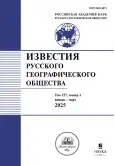Ecological Assessment of the Content of Copper and Zinc in Environmental Objects and in the Hair of the Population in the Oktyabrsky District of the Khanty-Mansiysk Autonomous Okrug-Yugra of the Tyumen Region
- Authors: Sindireva A.V.1, Belov M.A.1, Puzanov D.O.2, Veshkurtseva S.S.1
-
Affiliations:
- Tyumen State University
- LLC RN-Yuganskneftegaz
- Issue: Vol 157, No 1 (2025)
- Pages: 134-146
- Section: Articles
- URL: https://journal-vniispk.ru/0869-6071/article/view/292712
- DOI: https://doi.org/10.31857/S0869607125010096
- EDN: https://elibrary.ru/LHDMDE
- ID: 292712
Cite item
Full Text
Abstract
As part of the research in 2019–2022, an assessment of the content of copper and zinc in environmental components and hair of the population of the Oktyabrsky District of the Khanty-Mansiysk Autonomous Okrug-Yugra of the Tyumen Region was carried out. The content of mobile forms of trace elements in the soils of agrocenoses of the studied area varies depending on the type of soil: copper — from 0.57 to 0.85 mg/kg, zinc — from 13.5 to 22.53 mg/kg. These values do not exceed the maximum permissible concentrations, but are classified as high according to agrochemical gradations. The average content of copper and zinc in vegetable crops growing on the studied soils is: potatoes — copper 0.07 mg/kg, zinc — 0.34 mg/kg; carrots — copper 0.08 mg/kg, zinc — 0.50 mg/kg; beetroot — copper 0.07 mg/kg, zinc — 0.50 mg/kg. No excess of the maximum permissible concentrations was detected. The results of the analysis show that vegetables grown on sod-podzolic and podzolic soils have the highest concentrations of copper and zinc, unlike vegetables growing on gray forest soils.
The average content of copper and zinc in the water bodies of the Oktyabrsky district of the Khanty-Mansi Autonomous Okrug is: copper — 0.025 mg/l, zinc — 0.65 mg/l, which also does not exceed the permissible values and at the same time is characterized as low.
The content of copper and zinc in the hair of the population permanently residing in the Oktyabrsky district was studied. The dependence of the level of trace elements in biosubstrates on gender, age and place of residence has been established. With age, the average copper and zinc content in the hair of the population increases. The amount of these elements also depends on gender: women (average copper content — 59.65 mg/kg, zinc — 212.47 mg/kg) have more than men (average copper content — 21.87 mg/kg, zinc — 152.53 mg/kg). The relationship between the content of copper and zinc in water and in the hair of the inhabitants of the region has been established, which allows us to conclude that drinking water is one of the sources of these elements for humans.
Keywords
About the authors
A. V. Sindireva
Tyumen State University
Author for correspondence.
Email: sindireva72@mail.ru
Russian Federation, Tyumen
M. A. Belov
Tyumen State University
Email: m.blvv@yandex.ru
Russian Federation, Tyumen
D. O. Puzanov
LLC RN-Yuganskneftegaz
Email: puzanov31292@mail.ru
Russian Federation, Nefteyugansk
S. S. Veshkurtseva
Tyumen State University
Email: king805@mail.ru
Russian Federation, Tyumen
References
- Alieva A. K., Kubalova L. M. Biologicheskaya rol’ himicheskih elementov v zavisimosti ot polozheniya v periodicheskoj sisteme D.I. Mendeleeva // Sovremennye naukoemkie tekhnologii. 2014, s. 83.
- Dobrinskij L. N. Ekologiya HMAO. // Izd. Soft-Dizajn. Tyumen’. 1997, s. 288.
- Klinicheskaya laboratornaya diagnostika: nacional’noe rukovodstvo: v 1 t. — T. I / Pod red. V. V. Dolgova, V. V. Men’shikova. — M.: GEOTAR-Media, 2012, s. 248-249.
- Nikitin D. P., Novikov Yu. V. Okruzhayushchaya sreda i chelovek. — M.: Vysshaya shkola, 1986, s. 415.
- Protasova N. A. Mikroelementy: biologicheskaya rol’, raspredelenie v pochvah, vliyanie na rasprostranenie zabolevanij cheloveka i zhivotnyh // Izd-vo Sorosovskij obrazovatel’nyj zhurnal, № 12, 1998, s. 32–37.
- Sindireva A. V., Puzanov D. O., Bukin A. V., and Tomilova E. V. Soderzhanie medi i cinka v sisteme pochva-rastenie na primere Oktyabr’skogo rajona Hanty-Mansijskogo avtonomnogo okruga — YUgry // Vestnik Krasnoyarskogo gosudarstvennogo agrarnogo universiteta, № 6 (159), 2020, pp. 99–104.
- Skal’nyj A. V., Sal’nikova E. V., Kudryavceva E. A., Kustova A. S. Akkumulyaciya tyazhelyh metallov i mikroelementov v volosah naseleniya Orenburgskoj oblasti // Mikroelementy v medicine, 2012, s. 42–45.
- Tedeeva I. R., Kubalova L. M. Biologicheskaya rol’ medi i ee soedinenij // Izd Severo-Osetinskij gosudarstvennyj universitet im. K. L. Hetagurova Vladikavkaz, 2014, s. 92.
- Titov A. F., Talanova V. V.,Kaznina N. M., Lajdinen G. F. Ustojchivost’ rastenij k tyazhelym metallam // Institut biologii KarNC RAN. / Petrozavodsk: Karel’skij nauchnyj centr RAN, 2007, s. 172.
- Chizhov B. E. Les i neft’ Hanty-Mansijskogo okruga — YUgry. // Izd. Tyumen’. Yu. Mandriki, 1998, s. 105.
- Sheudzhen A. H. Biogeohimiya. Majkop // GU- RIPP “Adygeya”, 2003, 1028 s.
- Giovana Clarice, Poggere Amanda, Gasparin Julierme, Zimmer Barbosa, George Wellington, Melo Rodrigo S., Corrêa Antonio, Carlos Vargas Motta. Soil contamination by copper: sources, ecological risks, and mitigation strategies in Brazil.” Journal of trace elements and minerals, 4 (2023).:100059–100059. https://doi.org/13.1016/j.jtemin.2023.100059.
- Kabata-Pendias A. Trace Elements in Soils and Plants // A. Kabata-Pendias. 4th Edition. Boca Raton, FL: CRC Press, 2011. 548 p.
- Kumar Vinod et al. Copper bioavailability, uptake, toxicity and tolerance in plants: A comprehensive review. // Chemosphere vol. 262 (2021): 127810. https://doi.org/10.1016/j.chemosphere.2020.127810
- Schoofs Hannah, Joyce Schmit, and Lothar Rink. 2024. Zinc Toxicity: Understanding the Limits // Molecules 29, no. 13: 3130. https://doi.org/10.3390/molecules29133130
Supplementary files






